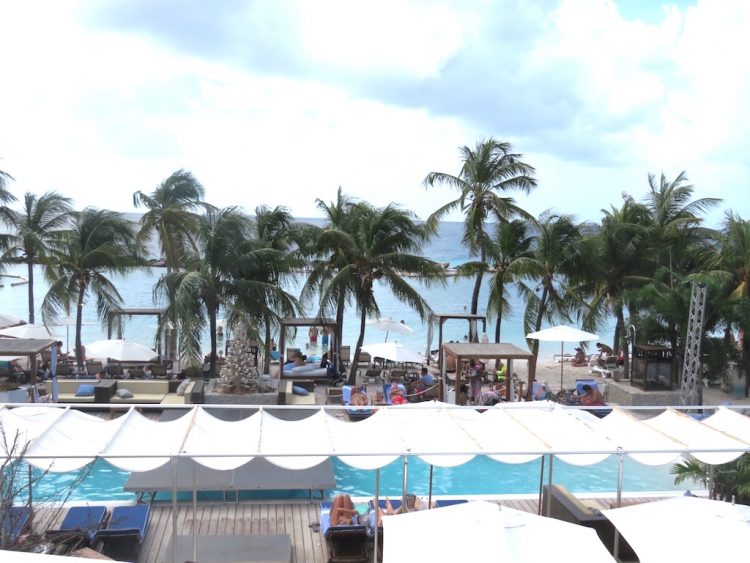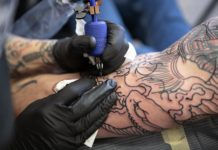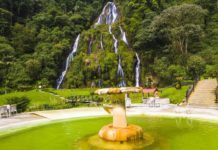Curaçao is one of the Caribbean’s better-kept secrets. It’s a large island located just off the coast of Venezuela so it’s easy to get to from Colombia. Curaçao is one of the ABC islands – Aruba, Bonaire and Curaçao.
Not many Americans have discovered Curaçao. It appears to be a more popular vacation place for Europeans. Curaçao was a Dutch territory beginning in the 1600’s.
It became a separate country within the Kingdom of the Netherlands in 2010 with the dissolution of the Netherlands Antilles.
So you will find many Dutch tourists in Curaçao with direct flights available from the Netherlands. The official languages on the island are Dutch, English and Papiamentu, which is a Portuguese creole language.
Most of Curaçao’s population is able to converse in at least two of the languages of Dutch, English, Papiamentu and Spanish. It’s not uncommon to hear Curaçaoans ping-pong between multiple languages.
For currency, the country uses the Netherlands Antillean guilder (also called the florin), which is pegged at a stable 1.77 to the USD. US dollars are also widely accepted on the island. ATM machines in Curaçao provide both guilders and US dollars.
Comparing Curaçao with San Andres
I have been to San Andres a couple times in the past in vacation. And I went to Curaçao for the first time between Christmas last year and New Years this year with my Colombian wife.
Both my wife and I agree that Curaçao is a much better vacation place than San Andres. Curaçao is a much bigger island (171 square miles) compared to San Andres (only 10 square miles).
It also has a much bigger population of over 150,000 compared to San Andres with only about 70,000.
So there is more of everything in Curaçao – more things to do, more beaches, more restaurants, more nightlife, more hotels and all-inclusive resorts and more shopping.

Why Curaçao?
It’s a big island with so much to do. Curaçao isn’t that expensive (compared to other Caribbean locations), the beaches are beautiful, the people are friendly and the food is great.
The island has the port city of Willemstad, which is a Unesco World Heritage site filled with candy-colored Dutch colonial buildings. It exudes European and tropical vibes and is a popular cruise port. We saw several different cruise ships arrive while we were there.
In Willemstad you’ll find inviting bars, good dining spots and the floating market, where fruit vendors from Venezuela dock to sell.
There are at least 60 beaches to be found on the island. I even bought a guide to the beaches to find out which are the best. There are small and large beaches; sandy to coral; private to semi-private; and shady to not shady beaches.
Some of the best beaches we went to included Jan Thiel Beach and Madero Beach (both with very many amenities) and Playa Kenepa Grande and Playa Kalki.
You can find great diving and snorkeling on the island. I talked to several divers that said the shore diving is so good you don’t even need to get on a boat.
There are countless boating activities as well as the Curaçao Sea Aquarium, which has the Dolphin Academy with the opportunity to swim with dolphins. There are ATV and buggy tours and well as the Hatu Caves.

Curaçao also has many good restaurants with over 275 listed on TripAdvisor. Of course there are many seafood restaurants found on the island. You can also find Chinese, Thai, Italian, steakhouses and many other types of food.
The best restaurants we went to while on the island were Baoase Culinary Beach Restaurant, Restaurant Fishalicious, The Wine Cellar, Kome and Gouverneur de Rouville.
The local cuisine is a flavorful blend of Dutch and Indonesian. Ayaka (meat tamales wrapped in banana leaves), sult (pickled pigs ears and feet) and kabritu (stewed goat) are some of the island’s favorite dishes.
For drinks the island is famous for its Blue Curaçao liqueur. This is a liqueur flavored with the dried peel of the laraha citrus fruit, grown on the island.
Curaçao is also located outside the hurricane belt, so traveling during storm season isn’t quite as risky as it is in other parts of the Carribean.

How to Get There?
To get to Curaçao from Colombia, Avianca has non-stop flights from Bogotá, which are about 1.5 hours. And Insel Air has non-stop flights from Medellín and Barranquilla. Copa also has flights from Colombia with a connection in Panama.
To get there from the US, American Airline has non-stop flights from Miami and Charlotte. And JetBlue has non-stop flights from NYC-JFK.
To get to Curaçao from Europe, KLM has non-stop flights from Amsterdam.
We flew Avianca from Medellín with a connection in Bogotá and the cost was $623 round-trip per person for flights to the island. This was during the Christmas holiday, which is a peak travel time. So flights are more expensive.
Other times of the year, flights will be much less expensive. I looked in February and found flights from Medellín to Curaçao on Insel Air available for $350 round-trip.

Where to Stay?
There is a wide range of options on the island with a wide range of prices.
Big name hotel chains like Marriott and Hilton have beach hotels. There are all-inclusive beach resorts like Baoase Luxury Resort and Van der Valk Kontiki Beach Resort.
You can also find many Airbnb rentals and several hostels on the island.
We stayed in a nice Airbnb rental apartment. This was one of four apartments in a large shared home with a pool. It was in a upscale neighborhood that was very quiet at night. Our cost was under $100 per night during the high season.
Some Curaçao Tips
Rent a car! You need a car so you can appreciate all the sites that the island offers. A car is absolutely needed as it’s a big island and everything is spread out.
I read one travel blogger’s post about Curaçao who was disappointed. But he didn’t do his homework and didn’t rent a car – so his disappointment is understandable.
Forget taxis and forget taking the bus. I only saw four taxis the entire time we were on the island and this was at the airport. Taxis are expensive – for example, it’s at least $40 from the airport to the Sea Aquarium hotel area.
We saw bus stops but never even saw a bus once. I understand from locals the buses only run about every couple hours.
Get a good map. The roads in general are not well marked and they have some confusing roundabouts.
Use eGates. If you are American, Canadian or Australian you can use eGates, which are automated immigration gates in Curaçao without lines. You will need to fill out an ED-card online before you go to use the eGates.
Over 80 nationalities including Colombians can enter the country without a visa as tourists. Here’s a list of all the countries that do not require a visa to enter Curaçao.

The Bottom Line
We had a great time in Curaçao. In the 10 days we were there we only scratched the surface of what the island has to offer.
If you are looking for a nice quaint island with many beautiful beaches, great nature, lots of activities, good food, relaxing in Curaçao is great. Now that we have discovered Curaçao it is very doubtful we will ever return to San Andres.
Here are nine more photos from the island that may convince you it is worth visiting:





















Thanks, this is a great article, very informative. I want to go!
Hi John,
Thanks. We ended up going during the peak season when airfare and lodging is more expensive.
I suggest going from May to November, which is during the off-peak season, when you’ll find lower priced airfares and lower priced lodging.
Nice article Jeff but the beaches are better on Aruba. Although I’m a little bias because I live on Aruba.
Thanks. I have also been to Aruba – it’s very nice also and I agree it arguably has better beaches. But Aruba has much fewer beaches (about 14) than are found on Curaçao (which has about 60). Aruba is a smaller island that is more touristy and more Americanized in my opinion. Also it has a smaller population – so fewer restaurants.
The terrain is more rugged and mountainous on Curaçao. I also liked finding the small hidden beaches on Curaçao, far from the resorts – there are so many of them.
Both islands have their pluses and minuses. But both islands definitely beat San Andres in my opinion. And both Curaçao and Aruba are easily accessible from Colombia.
Let’s grab some dinner next time your on the island. We will show you some hidden gems.
Hi, Happy to read a nice article about my second home 🙂 Just a little comment regarding the local food: It is not a mix between Dutch and Indonesian. The Indonesian type of restaurants you find all across the island are mostly Surinamese restaurants (Suriname, where I was born, is a former Dutch colony with a very mixed population. Indonesians make up a large part of the population of Suriname. They were brought in as contractors to work on the fields after slavery was abolished. There are a lot of Surinamese now living in Curacao). The real local food exists out of Arroz Moro which is a rice and beans mix, Funchi which is a polenta, Tutu which is a funchi with black eyes peas mixed in and is sweet of taste, Stoba which is a meat stew often made with goats meat called kabritu, Jambu which is a okra soup with meat and seafood all mixed in there and you can find a lot of fresh seafood that is often accompanied with funchi or arroz moro. Ayaka is mostly eaten only during Christmas time. It is very different from Indonesian food!
It’s my first time to travel to Curaçao. I will be there from November 7-18. I am not a beach person and beside living in the Philippines also provides us with many beaches. Should I make a side trip to Columbia in my flight back to Amsterdam? If so, which part of Columbia and for how many days in each country?